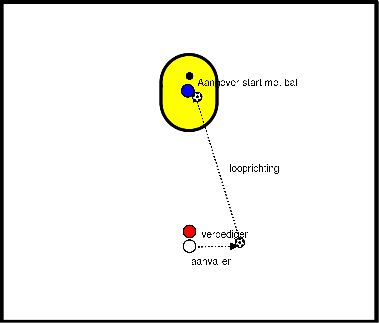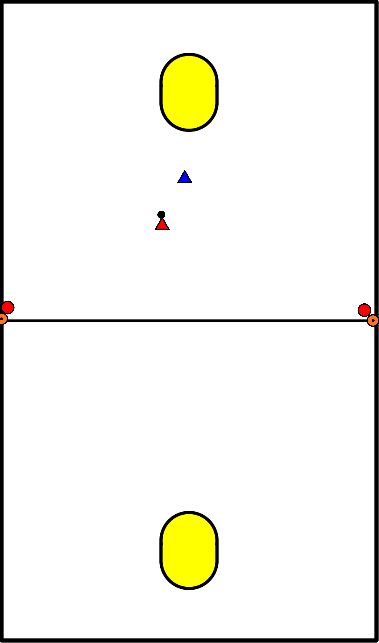Korfball drills for technique defense
- In the 1:1 you try to score 2x in 1 minute.
- The defender makes choices which ball she defends.
- The attacker and the passer play this out together.
- attack, defend and pass each 3x 1 minute.
- You have 2 teams and you have to play together to get the ball into the opponent's box.
- Your opponents can cover you but they can also intercept
- If this happens, the other team may attack and try to get the ball into the other team's box
- You need a 3 or 4 team to defend the run through.
- One person under the basket with the ball and possibly also a catcher.
- In front of the basket, an attacker and a defender, at about 5-6 meters from the basket (at far shot distance).
- The person under the basket (attacker) has the ball.
- The attacker runs sideways (right or left) and gets the ball from the person in charge.
- The attacker throws the ball back to the attacker and goes in a straight line to the basket and makes a run through or in out shot (if the run through is too well defended).
- The defender stays in the right place to prevent the run through.
- Point of attention defense:
- Stay close to the attacker
- Keep your knees bent
- Do not turn around when the ball is thrown
- Do not run after your opponent

- You have two attackers on the side in the middle between two baskets.
- The attacker must try to score with the help of the two players.
- At an interception, the defender becomes the attacker.
- When a goal is scored, the attacker gets a bonus and is allowed to keep attacking, only now he has to attack the other basket.
- When three goals have been scored, the winning attacker is rested and exchanged with a declarer.

In short: practicing various shooting variants in a fun competition form.
- Organization: per group a basket and a ball, the baskets are preferably (but not necessary) arranged in a circle or rectangle.
- The number of persons per group is less important (but all groups are about the same size).
- The first assignment for the groups is: score 10 goals.
- When you have completed this assignment, the person who scored the last goal runs to the trainer to pick up the next assignment.
- Which group completed all assignments first?
- The trainer walks around, encouraging, or correcting.
- He has a piece of paper with him with a row of assignments on it.
- When someone comes to pick up the next assignment, first ask which one has just been done (this can vary considerably over time) and then hand out the next assignment.
- An example list: 10 walk-through balls, 15 penalty shots, 5 8-meter shots, 10 walk-through balls from behind the basket, 5 dodge balls next to the pole, 10 6-meter shots.
- Everything is possible of course, a lot of momentum is gained if the number of goals to be scored is kept small.
- 10 walk-through balls
- 20 small oppertunities
- 6 remote shots
- 10 penalty throws
- 1 backwards
- 4 against 4.
- Pay attention to the basic set-up, to the ball pace and to the movement of the players, so that there is not just one attacker moving.
- Make the game more surprising by moving the ball, pulling the ball away, throwing it deep, etc.
- 3 attackers against 2 defenders.
- Attack within a radius of about five metres around the basket.
- All attackers may shoot.
- The defenders must try to score as few goals as possible.
- 5 x 1 minute. After each minute turn around.
- If the number is right, you can specifically train zone defence during the game: Zone defending.
- The defenders let go of their opponents as soon as they get further than about six metres from the post.
- The defender then has only one task: intercepting the ball by grabbing the rebound.
- This also includes letting the attacker shoot from distance.
- After all, if they do not shoot, they cannot catch the ball.
- Instruct certain attackers to give more pressure than others.
- The art of collective backfield defending is to give the pure shooters so much pressure that they prefer to leave the shot to a teammate who is as free as a bird (but who is deliberately left free by the defence because it is known that he 'can't shoot anyway').
You will play matches with even numbers, but instead of earning points by scoring, you can also earn points by catching the ball.
- Goal is worth 1 point
- Catching the ball after a shot(rebounding) 2 points
- A goal may only be scored by means of a deep line (run through from deep) or by what was trained in the previous drill.
- 4 balls in a row, a pylon 10 metres in front of the basket, pairs with 1 ball per basket. 1 player in front of the basket with the ball near the pylon.
- (Change every goal).
- Play 4 against 4 in which they must perform the above exercise 5 + 6, the defense may not predefend on the support there must be 1 shot allowed.
- After 1 shot 4-0 and again. Change task after 1,5 min.
- Two squares are going to play against each other between four baskets, one square defending two baskets and the other square defending the other two.
- Which pair shoots the most against the other pair?







